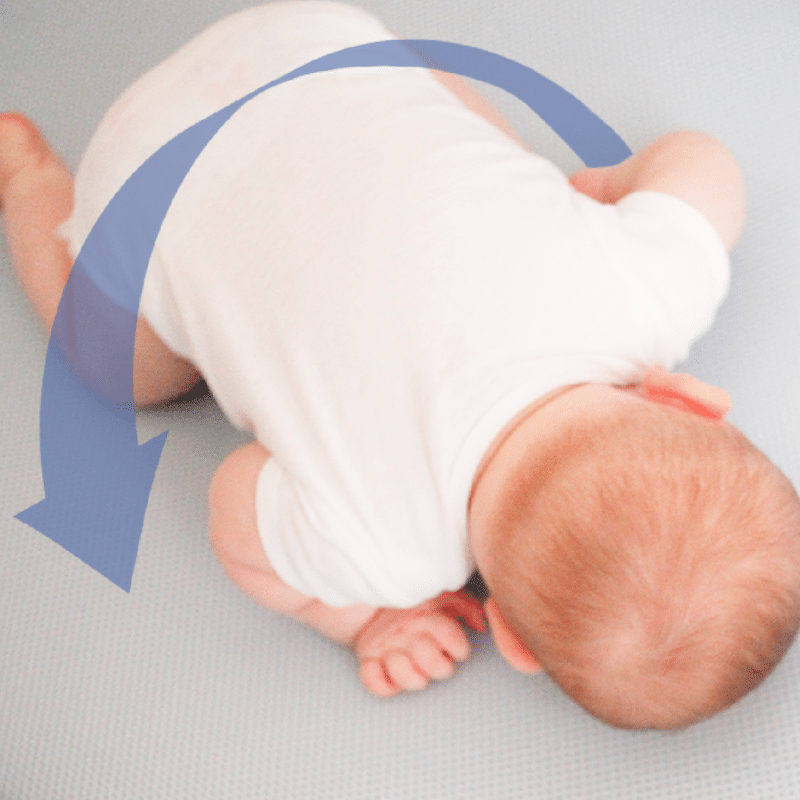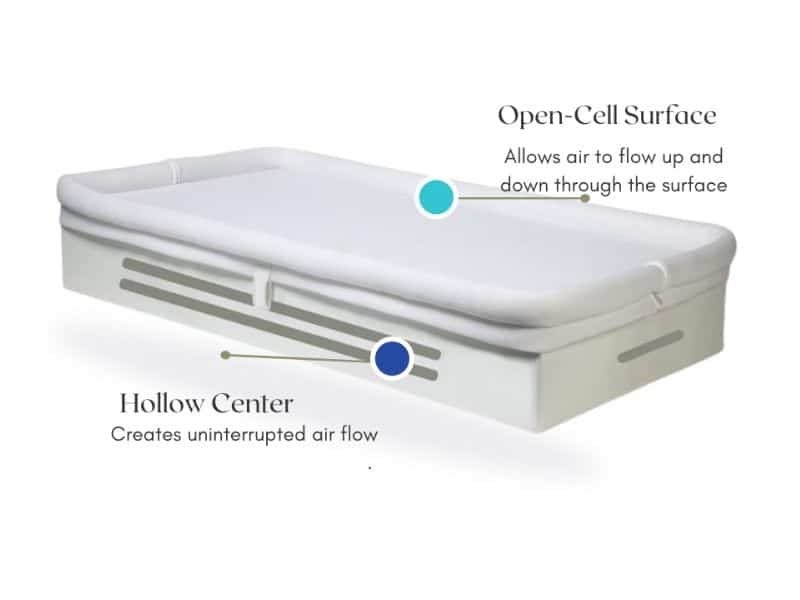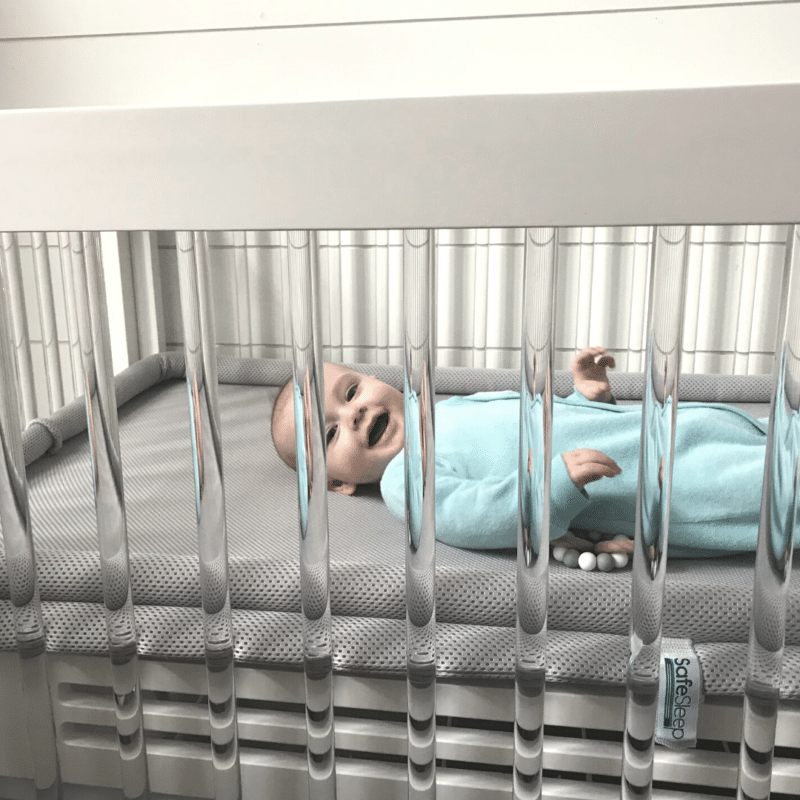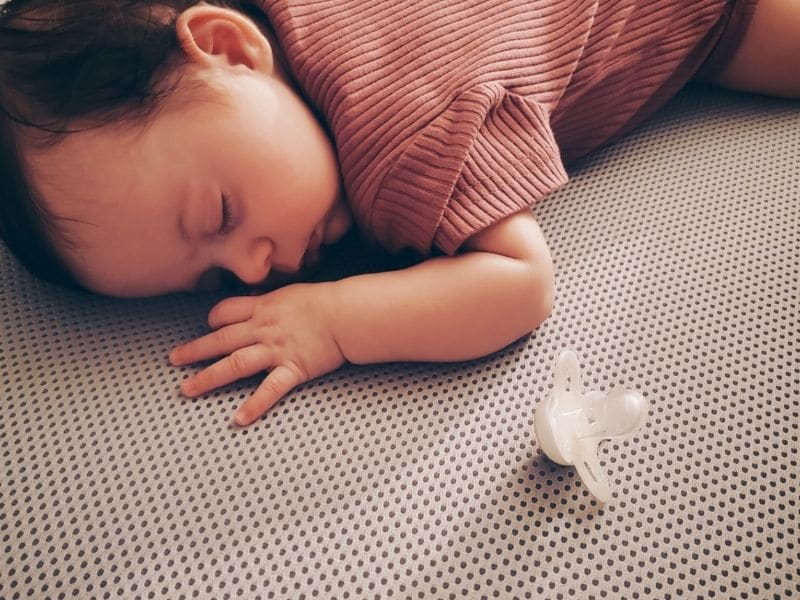How To Stop Baby Sleeping Face Down
Babe sleeping face downwards?
Finding your babe sleeping face downwardly is a scary feeling. The founders of SafeSleep® know too well. Sadly, they lost a loved ones who rolled in the middle of the night.
Fast forrad, the founders ready out to stop this from happening to other infants. Then don't worry. There is a solution.
Information technology'south truthful, nearly infants turn their heads when their not getting fresh oxygen. For instance when a baby is sleeping on their side and close to a bumper pad. Or, when your infant is a stomach sleeper and they are face downward. But unfortunately, some will not. We don't know which ones volition or will not. Consequently, we demand to remove the risk.
Unfortunately, there are over 3600 sudden unexpected babe deaths each year in the U.S.
The AAP has No Clear Guidelines – "When a Baby Begins Rolling Over or Baby is Sleeping Face up Downwards"
In 1944, a pathologist who studied infant deaths noticed that over 65% of infants who died from SIDS during the night were found confront down. All the same, it was not until the 1990's when SIDS researchers and medical professionals launched the back-to-sleep campaign.
Currently, the American Academy of Pediatrics (AAP) does not give parents clear directions on what to do when a babe begins rolling over. I take seen newborns rolling to their side to sleep. Trust me, this is very risky in the middle of the night.
Too often, these babies end upwards face downwards. Unfortunately, babies sleeping confront down are at a greater adventure of SIDS

Baby Sleeping Face Down?
We know the answer to the question, "should babies slumber on their back?"
Finally, we can easily answer the question that the Back-to-Sleep campaign does not! What do I do when my baby begins rolling over in slumber?
Impressively, the answer is a totally breathe-through crib mattress. The mattress is designed past a leading Pediatrician. Specifically, a baby can breathe unremarkably while sleeping face down. As a result, it is called the SafeSleep® Exhale-Through Crib Mattress.
It's unique design is tested and shows 100% oxygen rich air while breathing through the mattress. Breathable crib mattresses don't offer this characteristic.
It's no wonder, the SafeSleep® is the number one pediatrician recommended crib mattress. In fact, it is the just crib mattress pediatricians and respiratory therapists write prescriptions for infants who must tummy slumber for health reasons.
Shop the SafeSleep® Breathe-Through Crib Mattress

So Why Trust Us?
I never idea of becoming a crib mattress designer. In fact, I am running my own successful design house when a friend showed me a photo of a breathe-through crib mattress. He is enlightened of my blueprint skills. Consequently, he asks me to develop information technology.
As you lot can imagine, it is no easy determination. However, I am sure of one thing. A crib mattress of this type volition relieve a lot of young lives. Consequently, it is something I can't ignore.
Safer Crib Mattress Pattern For a Infant Sleeping Face Down
Immediately, I shows the idea to my sister. She is a leading pediatrician. Specifically, she serves on many national committees. Additionally, she is the writer of many peer-reviewed publications that advance the health of children.
She and I both know the thought is brilliant. For this reason, we know it is a project too important for babe safety sleep to overlook.
Enquiry of Crib Mattresses
First, we brainstorm by researching crib mattresses of all types. Specifically, we are looking at the many issues relating to their safety. Nevertheless, we are as well looking at their utilise in aiding an infant's wellness and development. Additionally, nosotros don't ignore sanitary and comfort problems.
Over time, our research includes a lot of peer-reviewed published studies to find out what the best and safest crib mattress should wait and feel like.
These studies include:
- crib mattresses.
- play yards.
- SIDS and other infant slumber related deaths.
- Flat Head Syndrome.
- Off-gassing & toxins used in mattresses
- Mold, pathogens and other bacteria in crib mattresses.
Some of the more notable studies include:
- Are bedding and rebreathing suffocation a crusade of SIDS?
- Rebreathing of exhaled air: importance as a machinery for the causal association between stomach sleep and SIDS
- Stomach sleeping and SIDS.
- Mechanical model testing of rebreathing potential in infant bedding
- Used baby mattresses and SIDS
- Sudden Death in Infants Sleeping on Polystyrene-Filled Cushions
- Clothing and bedding and its relation to SIDS
- Deformational plagiocephaly
- The "back to slumber campaign" and deformational plagiocephaly: is there cause for concern?
Sources for Our Crib Mattress Enquiry
Additionally, in our inquiry of creating the safest and best crib mattress, we use the following:
- Scientific testing
- American Academy of Pediatrics (AAP) safe slumber guidelines
- Consumer Products Prophylactic Commissions (CPSC) findings
- The National Found of Health (NIH) safe sleep guidelines
- Interviews with SIDS experts, AAP experts, child safety experts, pediatric lung specialists, and parents who lost an infant while sleeping.
Our Crib Mattress Research
We are familiar with AAP's data on safe sleep. So much so, we challenge the Safe Slumber Task Force in 2015. The result is an update to information on the benefits of breathe-through crib mattresses.
As mentioned prior, breathe-through crib mattresses allow a baby who is sleeping face up downward to breathe unremarkably through his mattress. This characteristic eliminates the risk of suffocation. Every bit important, it eliminates the chance of rebreathing.
AAP Safe Sleep Task Strength (SSTF)
I spoke with many of the SSTF Members. In fact, the Chair, Dr. Rachelle Moon and I wereboth expert witnesses in the same trial. The trial involved the death of a 7 ½ month one-time baby. Consequently, I was able to hash out with her the many issues the SSTF faces while creating safe slumber guidelines.
AAP Commission – Fetus and Newborns
Additionally, nosotros spoke with members of the AAP's Commission of Fetus and Newborns (COFN). COFN over sees the AAP's SSTF'south policies and guidelines.
In particular, COFN studies issues and electric current advances in fetal and neonatal intendance. Moreover, they make recommendations regarding neonatal practices. Also, they work with the American College of Obstetricians and Gynecologists (ACOG) to consider fetal issues. This bridges the gap between obstetrics and pediatrics in regards to fetus care.
Leading SIDs Researchers Who Did Studies on Baby Sleeping Face Downward
In add-on, we met with both Dr. James Kemp, Pediatric Pulmonologist. Also nowadays is Dr. Brad Thatch, a neonatologist. Both piece of work at St. Louis Children's Infirmary.
Markedly, both Kemp and Thatch are known as meridian SIDS researchers. Kemp is consistently on "The All-time Doctors in America" list.
Equally impressive, thatch received the Anaheim Honour for Slumber and Breathing Research in Infancy in 2000. Also, he is a long-term lath member of First Candle SIDS Alliance.
Significantly, both Doctors are are known for their SIDS research. Notably, they identified "rebreathing" as the well-nigh likely cause of many infant sleep related deaths.
To elaborate, rebreathing is when an infant continues to rebreathe their exhaled air (CO2). It's of import to remember, rebreathing is the leading theory backside SIDS deaths. Eliminating rebreathing run a risk is used for the most of the Safe Sleep Task Forces' rubber sleep guidelines.
New Legislation Pertaining to Crib Safety
In particular, their is new legislative activity outlawing the sale of bumper pads in the U.S. Part of this police is based on newborns rolling on their side to sleep with their faces wedged up confronting or near bumper pads. This position can crusade a baby to rebreathe his exhaled air.
We must ask ourselves, if a bumper pad is causing rebreathing when a infant rolls to their side while sleeping, what is the danger of a baby sleeping face downwardly? Obviously, most crib mattresses have more padding than a bumper pad. If a bumper pad is a danger for a babe sleeping on their side. We take to conclude a crib mattress with fiber make full is every bit every bit dangerous to a baby sleeping face down.
Epidemiologist
I met Dr. Ron Somers, an epidemiologist, on an infant list service. Dr. Somers is the creator of the Australia standard for crib mattress compactness. This standard is listed as AS/NZS 8811.1:2013.
The SafeSleep® Crib Mattress is the only mattress in the U.S. to pass his crib mattress firmness test. Even more than impressive, Dr. Somers gives our production an unsolicited endorsement.
The firmness standard is besides known equally "method 1: Crib Mattress – Examination for compactness. It is the merely examination to address the effect of minimum safety firmness for crib mattresses.
Dr. Somers is the old managing director of Epidemiology in Australia.

Pediatric Lung Specialist
Additionally, I met with Dr. Thomas H. Shaffer, Department of Biomedical Inquiry, Alfred I. duPont Hospital for Children. He is the Director of the Center for Pediatric Lung Inquiry. In detail, Dr. Schaffer helped create and over sees the testing used to determine CO2 evaporation levels on crib mattresses. Currently, his testing and methods are used past certified test labs.
Alarm from Dr. Ron Somers Regarding Breathable Crib Mattresses
In 2020, an article written past Dr. Somers is published in Babe & Nursery Products Alliance of Australia (INPAA). INPAA is similar to the CPSC in the U.S. Only more specifically, INPAA's fundamental goal is preventing injuries of children.
In the article Somers states, "If you actually want to protect your baby from suffocation, you lot need to be aware of faux mattress-prophylactic claims."
Somers explains, "Rebreathing of CO2 causes suffocation. With many of the so-called breathable crib mattresses, the CO2 (being heavier than air) sinks into the mattress. It is then sucked up by the infant for rebreathing. In other words, the carbon dioxide does not dissipate.
This is determined past a special test using a mechanical baby. The mechanical infant breaths in and out like a real infant. If a manufacturer doesn't show you their results on this kind of test, don't autumn for their safety hype."
SafeSleep® provides this test data and all their test data on their website.
Ironically, Somers is referring to the testing and methods created in part by Dr. Shaffer.
CPSC and SIDS Organizations
We spoke with representatives at the CPSC. Moreover, we used their data base of operations to find reviews and recalls of infant slumber products. Nosotros also spoke with many SIDS organizations. And, we also spoke with many parents who lost a baby to SIDS.
Nosotros are parents too
Even though we are both professionals, we are also parents. Nosotros know information technology tin be hard to alter crib sheets. Crib mattress messes are not strange to the states. And, we have our share of fussy sleepers.
Additionally, nosotros know the value of good sleep for both infants and parents. Consequently, comfort is also a priority.
Further, we also know the importance of offer quality at a off-white price. Believe it or not, we even considered the aesthetics. Parents shouldn't have to cull between safety and a beautiful nursery.
The effects chemicals in mattresses have on young children are known. Consequently, nosotros don't utilize any!
Research on Infants Who Rolled Over
In a written report conducted in New Zealand, researchers found that 3/four of the infants who died of SIDS were placed on their backs. The infants were found on their tummy. This ways, the infants rolled to a stomach position.² These researchers suggest, an infant's ability to escape a fatal situations during stomach sleep may be impaired by their lack of experience sleeping on their stomach.
After, their findings are supported past Dr. Moon and colleagues in their review of baby sleep related deaths in kid care settings.³
Unfortunately, infants who don't slumber on their stomach, but roll over are at higher risk of SIDS. This is now a common unintended consequence of the back-to-sleeping campaign.
Unfortunately, keeping a baby from rolling over is impossible.
Learn more about your babe's starting time milestone – baby rolling over. The medical professionals at SafeSleep® tell you everything you need to know when it comes to your babe rolling over.
SIDS Risk
The fact is, infants nether half-dozen months of historic period represent 90% of all SIDS-related deaths. SIDS risks is peaking between 1-4 months of age.
In a study on infant sleep, overall, 24% of infants are found sleeping on their breadbasket. Of this 24%, 12% of sixteen to 23-week-old infants placed on their backs or sides are institute sleeping face down. Additionally, iv% of infants aged 24 weeks or older rolled on their stomach. Lastly, xviii% of those placed on either their right or left sides, are plant on their stomach.iv
Nothing to Do with Skilful Head and Neck Control
Parents are oftentimes falsely assured that when their infant rolls side to side on their own, they are no longer at take chances of SIDS. Many parents believe if their baby has good cervix and head control, they are safe even if they are a face roller. Specifically, they believe a babe will turn their caput to avert a possible dangerous situation.
In stark contrast, scientific studies tell us differently.
According to SIDS expert Dr. Thach, "The first times babies who usually sleep on their backs or sleep on their sides coil or are put on their tummy, they accept a 19-fold increment in the risk of SIDS." The per centum increases to 40-fold if an infant is swaddled.
Detect our when you should cease swaddling your babe and how to properly transition them.
Thatch goes on to say, "Nosotros wonder if these babies, who detect themselves face down, do not plow their heads to breathe easier. If so, is it because their reflexes oasis't developed far enough. Or, because they simply don't wake up? Many parents believe that if a baby tin lift his head, he is okay to slumber on his tum. That is a false assurance." 5
Repositioning Baby Who is Sleeping Face Down
Some physicians tell parents to move an infant who is sleeping on their stomach to their back. However, turning a infant back over is unrealistic. Babies have several position changes per night. Furthermore, we know repositioning a sleeping infant is disruptive. This makes choosing the safest crib mattress a must.
In brusque, parents do not accept the time or free energy to watch their baby all night. Parents need sleep as well.
CO2 and Babe Sleeping Face Downwardly
Currently, the AAP recommends a firm crib mattress. However, a house crib mattress poses a high risk of rebreathing of CO2. This is confirmed in several studies. And allow's non forget that bumper pads are now banned for auction in the U.S. based on infants who have died.
In fact, according to a 2000 study published in Pediatrics, the findings prove a house mattress poses a high chance of rebreathing while an infant sleeps on their tum.vi There is no mention of the infants sleeping face up downwardly. Further, these findings are of relevance to more recent studies.
More recent studies show that babies who practise no normally sleep on their dorsum and roll or are placed on their stomach, take an increase risk of SIDS. Co-ordinate to the studies, 71% of SIDS victims unaccustomed to stomach sleep, are discovered sleeping confront down" v
CO2 Rebreathing and SIDS
Rebreathing CO2 is when a baby rebreathes their exhaled air. This normally occurs when a baby is sleeping on his tum and exhaled air is trapped around the baby's nose or mouth.
The result, trapped exhaled air causes the infant to breathe in more CO2 than oxygen. Specifically, if the baby does not wake up or respond appropriately death occurs.vii
Example of what is happening when a infant is sleeping confront down
Sit-in of Infant Suffocation Caused past Rebreathing CO2
*Source David Greenblatt Faculty of Mechanical Engineering science, Catamenia Control Laboratory
We know conventional crib mattresses with fiber make full can cause CO2 to accumulate. Additionally, vinyl covers, and quilted toppers can crusade even higher levels of CO2 aggregating. Even the folds of sheets causes CO2 to accumulate.
According to Dr. Kemp and Dr. Thach, these bedding materials human action to dull the dispersal of exhaled gasses (carbon dioxide), keeping the gasses near a face down baby's nose and oral fissure.
Equally a upshot, with each breath, the baby takes in an air mixture which is progressively less adequate to sustain life. Farther, the more decumbent an particular is to rebreathing (retaining CO2), the more hazardous the detail is. eight
Peer-Reviewed Studies on Crib Mattresses
SIDS experts agree, infants sleeping on the following surfaces evidence increased run a risk of suffocation and rebreathing CO2
- fiberfill crib mattresses
- quilted surfaces
- soft surfaces
- pillow-like surfaces
- vinyl pads
- folds of sheets
- mattresses filled with tea tree bark and other natural and artificial loose fibers
Eliminating Suffocation and Rebreathing Risks
As mentioned above, rebreathing CO2 is a known danger of infants sleeping on their stomach. Another danger is suffocation. Rebreathing CO2 is actually a grade of suffocation. Unlike airway obstacle, rebreathing leads to hypoxia. Hypoxia is a lack of oxygen to human organs.
Crib mattresses with fiber fill trap CO2. They as well cause suffocation if they allow for airway obstruction. The design of the SafeSleep® eliminates both suffocation risk and the risk of rebreathing.
No Fiberfill or Core
To protect babies from suffocation risk, it'south important they can breathe normally when face down. In lodge to reach this, a crib mattress must be completely breathe-through. To be completely exhale through, a crib mattress cannot have any fiberfill or core fabric to block air period or trap harmful CO2.
Fiberfill and other core materials interfere with air catamenia. Additionally, they are known to retain higher levels of CO2.
SafeSleep® has no core or fill fabric of any kind. Instead, the base of the mattress is a hollow box with side openings. This design allows air to broadcast uninterrupted.
Air-Permeable, Breathe-Through Surface
In order to be effective, the surface has to be air-permeable. It's important that the surface a baby is sleeping face down on exist completely exhale-through. This means the surface must exist open celled. An open-celled surface allows air to travel up and downwards apace with no obstruction.
Remarkably, the SafeSleep® is tested showing 100% oxygen-rich air while a baby is breathing through the SafeSleep® mattress. The surface is a medical grade spacer fabric. This fabric allows air to refuse and down without obstruction. Not to mention, testing shows a significantly high rate of airflow.
In fact, the SafeSleep® has an air-permeability charge per unit of over 330 times other crib mattresses tested. That's a lot of good, healthy, air-flow!
A Existent Solution for a Real Problem
Developed by People with Existent Knowledge – A Pediatrician and Safe Sleep Expert
The SafeSleep® breathable crib mattress is designed to go on a baby who is sleeping on his side, his tummy, or sleeping face down safe.
- At that place is no fiberfill or cadre to trap CO2.
- SafeSleep® breathable crib mattress has a hollow center and side openings.
- The surface is made from an open-prison cell fabric that allows air to flow up and down with no pause.
- No crib sheets are used.
- The surface is 100% machine washable.
- No fire retardants or waterproofing chemicals are used.
- No bathtub or shower is needed for cleaning.
This revolutionary design creates an oxygen-rich environs, even when an infant is face down all nighttime. The design besides creates a user-friendly and easy to clean crib mattress for parents.

Scientific Data on Air-Permeable Crib Mattresses
Scientific data shows some air-permeable mattresses have a "significantly" reduced risk of rebreathing of CO2. 9,x Specifically, the SafeSleep® Breatthe-Through Crib Mattress is tested for CO2 retention. It has a whopping tenfold decrease in CO2 retention when compared to a fiberfill mattress.
To illustrate, information technology takes 120 seconds for CO2 to evaporate from a firm fiberfill crib mattress. Nonetheless, it takes less than .v (1/2 a second) for information technology to evaporate from the SafeSleep® Crib Mattress. 10
Fact, an babe takes a breath every one-2 seconds. This means, CO2 on the SafeSleep® crib mattress is gone before your babe takes his side by side breath of air – even if their confront is straight downward.
Determination
We cannot stand sentinel over our babies all night. Sleep is important for parents also. Finding your baby sleeping face down is a very scary feeling.
The problem is, we can't keep them from rolling. And we cannot keep turning them back over. Information technology'southward unrealistic since infants assume many position changes nightly. Not to mention, flipping them over is disruptive.
Sadly, nosotros know the horrible upshot of a baby simply rolling in the centre of the dark. Merely with that being said, we don't look parents to simply take our word for it.
Most importantly, the science provides the proof the SafeSleep® Breathe-Through Crib Mattress is the safest choice for a infant sleeping face down or on their stomach.
A lot of inquiry went into creating the SafeSleep® Breathe-Though Crib Mattress. Nosotros are proud we are contributing to the progress of keeping sleeping babies safety.
Additionally, nosotros are honored to exist recognized by many pinnacle medical professionals as bridging the safety gap non addressed past the back-to-sleep campaign – What to practise when an infant rolls over.
Is your infant sleeping face up down? SafeSleep® is more a breathable crib mattress. It is completely exhale-through.
Desire data on baby sleeping on stomach? Read our article, When Tin can Baby Sleep on Their Stomach
Study References:
-
Carleton, James Due north., Donoghue, Ann Yard., Porter, Warren K. Mechanical model testing of rebreathing potential infant bedding materials. Curvation Dis Child 1998;78:323–328
-
Mitchell EA, Thach B, Thompson J, Williams S. Changing infants' sleep position increases risk of sudden babe death syndrome. Curvation Pediatr Adolesc Med. 1999;153:1136–1141
-
Rachel Y. Moon, Kantilal M. Patel and Sarah J. McDermott Shaefer. Sudden Infant Death Syndrome in Child Care Settings. Pediatrics 2000;106;295
-
Willinger M, Hoffman HJ, Wu KT, et al. Factors associated with the transition to nonprone sleep positions of infants in the United States: the National Infant Sleep Position Written report. JAMA. 1998
-
Paluszynska DA, Harris KA, Thach BT. Influence of sleep position experience on ability of prone sleeping infants to escape from asphyxiating microenvironments by changing head position. Pediatrics, Dec. 1, 2004.
-
Patrick 50. Carolan, William B. Wheeler, James D. Ross and RCP*; and James S.Kemp, Potential to Prevent Carbon Dioxide Rebreathing of Commercial Products Marketed to Reduce Sudden Infant Death Syndrome Chance, Pediatrics 2000 105;774
-
Patel, Aloka L., Harris, Kathy, Thack, Bradley T. Inspired CO2 and O2 in sleeping infants rebreathingfrom bedding: relevance for sudden infant expiry Journals.Physiology.org/doi/pdf/10.1152/jappl.2001.91.6.2537
-
Kemp, James S., Nelson, Verna Due east., Thach, Bradley T., Concrete Backdrop of Bedding That May Increase Risk of Sudden Infant Death Syndrome in Prone-Sleeping Infants. Journal of Pediatrics,July,1994,Vol.36,no.S1
-
Bar-Yishay E, Gaides G, Goren A, Szeinberg A. Aeration properties of a new sleeping surface for infants. Pediatr Pulmonol. 2011;46(2):193–198 342. Colditz PB, Joy
-
William Westward. Play tricks, MD and Thomas H. Shaffer, Carbon Dioxide Rebreathing Assessment of SafeSleep® Crib Mattress Sample. Intertek., wouso7330
Related Topics
Source: https://safesleeptech.com/baby-sleeping-face-down/

0 Response to "How To Stop Baby Sleeping Face Down"
Post a Comment